
Siege of Orleans Execution of Joan Fall of Rouen Battle of Castillon
The Siege of Orleans
12 October 1428 – 8 May 1429
(1.2a-c, 1.4a-c, 1.5a, 1.6a, 2.1a-b, 2.2a; The Rise of Joan of Arc)
Melvin Bragg on the Siege of Orleans, BBC Radio 4
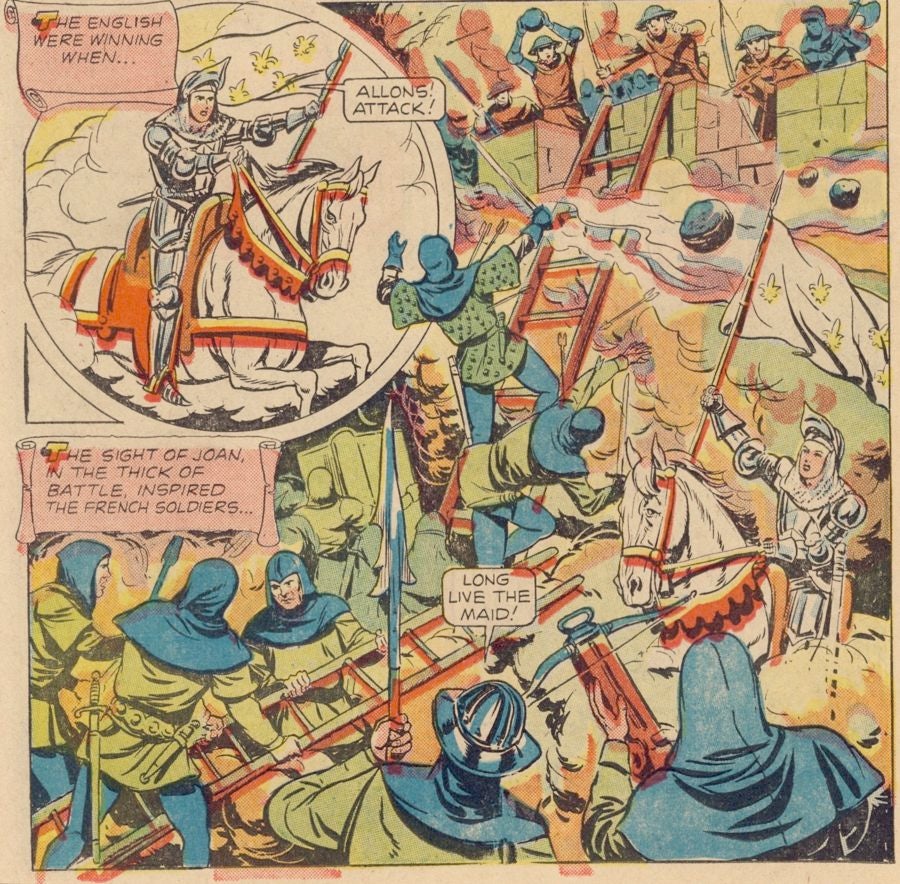
Excerpted from Rickard, J (18 January 2011), Siege of Orleans, 4 February-March 1563, http://www.historyofwar.org/articles/siege_orleans_1563.html
The siege of Orleans (4 February-March 1563) was the last major military action of the First War of Religion, and ended after the assassination of Duke François of Guise, the last major Catholic leader in the field.
Guise had become the sole Catholic leader as a result of the battle of Dreux (19 December 1562). Although this had been a Catholic victory two of their leaders had been lost - Anne, duke of Montmorency having been captured and Marshal Saint-André captured and then murdered. On the Huguenot side the Prince of Condé had also been captured, leaving Admiral Coligny as the main Protestant commander.
In the aftermath of the battle Coligny retreated to the main Huguenot stronghold at Orleans, before on 1 February leaving the city with his German cavalry. François d'Andelot was left to command the defence of the city.
The duke of Guise reached Orleans on 4 February, and the siege began on the following day. On 6 February the Catholics had their first major success. The main city of Orleans, on the north bank of the Loire, was connected by a bridge to the suburb of Portereau on the southern bank. The suburb had weaker defences than the main city, but its walls were protected by two bastions, one garrisoned by Gascon infantry and the other by German infantry. Guise sent his main army to make a feint against the bastion held by the Gascons, while a small force captured the other bastion. The suburb was quickly in Catholic hands, and the defenders only just prevented them from crossing the bridge into he main part of the city.
The siege was noteworthy for one of the first uses of brass shells in warfare. The English Ambassador, Sir Thomas Smith, who was observing the siege with the Royal court at Blois, recorded his impressions in a letter to the Privy Council -
'I have learned this day, the fifteenth instant, of the Spaniards, that they of Orleans shoot brass which is hollow, and so devised within that when it falls it opens and breaks into many pieces with a great fire, and hurts and kills all who are around it. Which is a new device and very terrible, for it pierces the house first, and breaks at the last rebound. Every man in Portereau is fain to run away, they cannot tell whither, when they see where the shot falls'.
The nature of the siege, and of the entire war, changed dramatically on 18 February. The Royal siege works had progressed to the point where Guise was planning to launch an attack on the city on 19 February, and on the evening of the 18th he visited the works to inspect them. On his way back from this inspection he was shot and mortally wounded by a man on horseback. The assassin initially made his escape, but was later arrested when he became lost in the dark. The assassin, Jean Poltrot, lord of Mérey in Angoumois, was motivated by a desire to get revenge for Guise's persecution of the Huguenots. He was eventually executed for his crime, but outlived Guise, who died on 24 February 1563.
The death of Guise left Catherine de Medici free to begin peace negotiations. On 8 March the prince of Condé and the duke of Montmorency were both released, and a peace began on the same day. The basis of the Edict of Amboise was agreed on 12 March, and the treaty was signed by Condé on 18 March. The Huguenots won a limited amount of legal toleration, and four years of peace followed before the outbreak of the Second War of Religion.
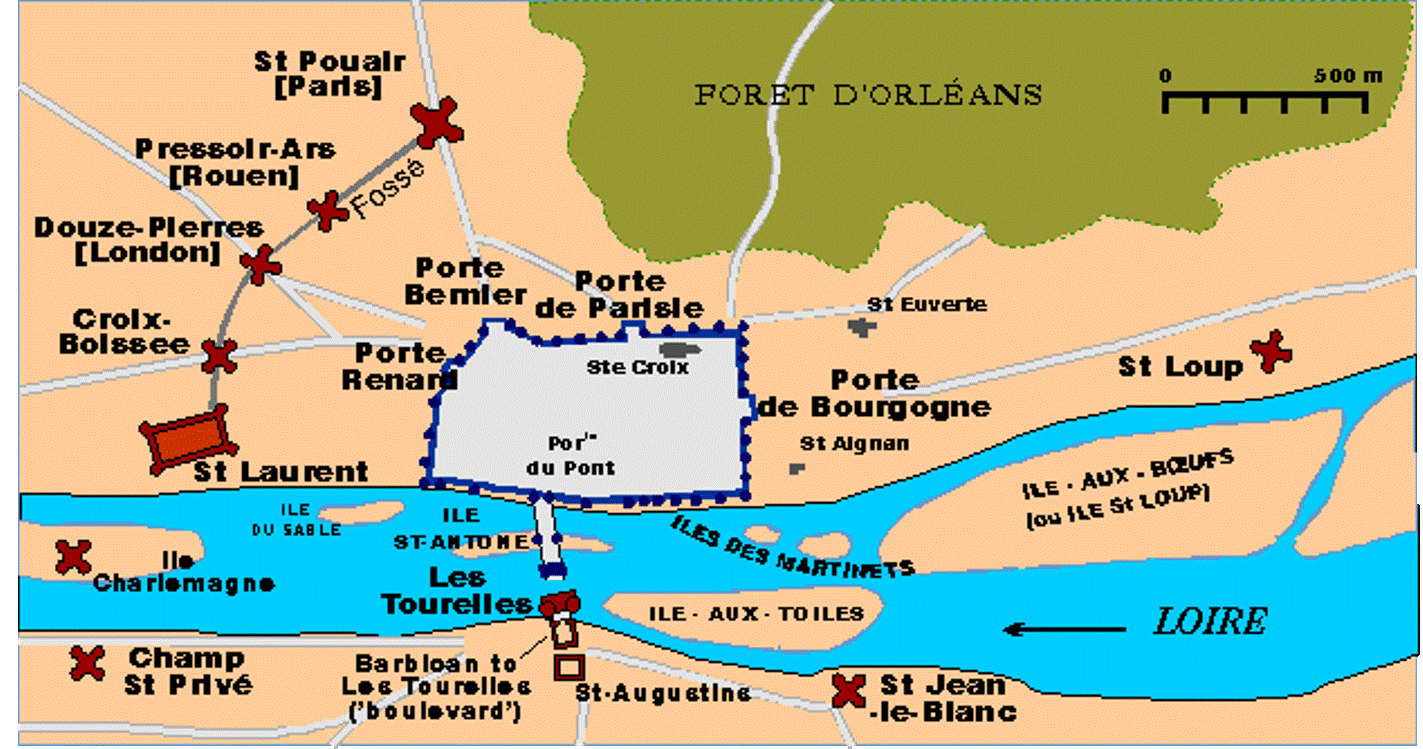
The Execution of Joan la Pucelle
30 May 1431
(5.5a-c, historically in Rouen, but in Anjou in Shakespeare)
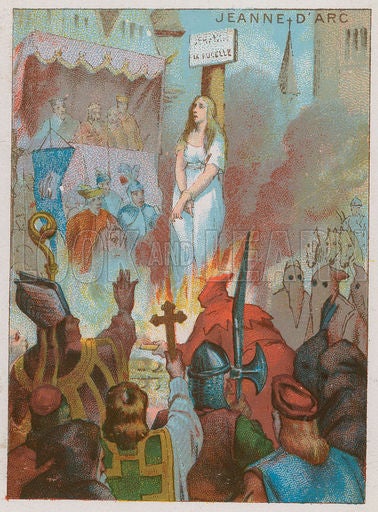
Solved at last: the Burning Mystery of Joan of Arc
Excerpted from Joan of Arc - Facts and Summary. http://www.history.com/topics/saint-joan-of-arc
After such a miraculous victory, Joan’s reputation spread far and wide among French forces. She and her followers escorted Charles across enemy territory to Reims, taking towns that resisted by force and enabling his coronation as King Charles VII in July 1429. Joan argued that the French should press their advantage with an attempt to retake Paris, but Charles wavered, even as his favorite at court, Georges de La Trémoille, warned him that Joan was becoming too powerful. The Anglo-Burgundians were able to fortify their positions in Paris, and turned back an attack led by Joan in September.
In the spring of 1430, the king ordered Joan to confront a Burgundian assault on Compiégne. In her effort to defend the town and its inhabitants, she was thrown from her horse, and was left outside the town’s gates as they closed. The Burgundians took her captive, and brought her amid much fanfare to the castle of Bouvreuil, occupied by the English commander at Rouen.
In the trial that followed, Joan was ordered to answer to some 70 charges against her, including witchcraft, heresy and dressing like a man. The Anglo-Burgundians were aiming to get rid of the young leader as well as discredit Charles, who owed his coronation to her. In attempting to distance himself from an accused heretic and witch, the French king made no attempt to negotiate Joan’s release.
In May 1431, after a year in captivity and under threat of death, Joan relented and signed a confession denying that she had ever received divine guidance. Several days later, however, she defied orders by again donning men’s clothes, and authorities pronounced her death sentence. On the morning of May 30, at the age of 19, Joan was taken to the old market place of Rouen and burned at the stake. Her fame only increased after her death, however, and 20 years later a new trial ordered by Charles VII cleared her name. Long before Pope Benedict XV canonized her in 1920, Joan of Arc had attained mythic stature, inspiring numerous works of art and literature over the centuries and becoming the patron saint of France.
The Fall of Rouen
29 October 1449
(3.2a-e, 3.3a; French re-take English territory)
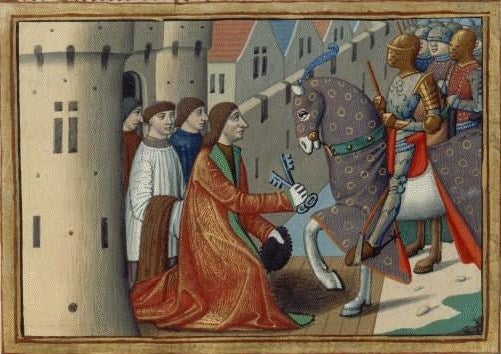
THE FALL OF ROUEN
Excerpted from Nicholle, David. The Fall of English France 1449-53 (Campaign). Oxford: Osprey Publishing, 2012.
A well-coordinated assault by Charles VII and François I now reconquered much of Normandy in less than a year, largely because the English were hopelessly unprepared but also because the majority of the Norman population supported the French cause. Although the Duke of Burgundy was preoccupied with a rebellion in Flanders, the French were reportedly strengthened by some Burgundian troops while several French compagnies were redeployed from peacetime locations in the south, including some of Charles VII’s foreign forces. This French campaign was conducted by four separate armies, the first success being achieved by Pierre de Brézé, who seized the vital town of Verneuil on 19 July 1449. The place was supposedly betrayed by a local militiaman whom the English had beaten for sleeping at his post. On 6 August King Charles VII himself crossed the river Loire to take command, eventually joining forces with the army led by Jean de Dunois. On 8 August the French took Pont-Audemer and hardly a week then seemed to pass without another major English-held town or castle falling. On 26 August the inhabitants of Mantes forced the English garrison to surrender by seizing control of a tower and gate. Around the same time, Roche-Guyon was reportedly surrendered by its captain in exchange for an assurance that he could keep the lands of his French wife. In September, the Duke of Brittany formally handed over to King Charles VII’s representative all those places the Breton army had captured in western Normandy. Meanwhile, in southern Normandy the Duke of Alençon seized the major fortified city of Alençon, which had been beyond his control for decades. On 13 October there was a procession of children through Paris to give thanks for these astonishing victories, though the campaign was certainly not over. Three days later Charles VII and Dunois besieged the Norman capital of Rouen, which fell in less than a week. Here the English fought hard but not for long, the inhabitants being divided, some sending a deputation to England begging for support while others insisting that the garrison surrender. Edmund Beaufort was in overall command and agreed to negotiate. Realizing that no help could arrive from England in time, he agreed to surrender. His more belligerent subordinate, Talbot, was one of eight hostages handed over to the French while Beaufort and the garrison were allowed to march to English-held Caen.
The Siege of Bordeaux/The Battle of Castillon
17 July 1453
(4.5a, 4.6a; the Death of Talbot)
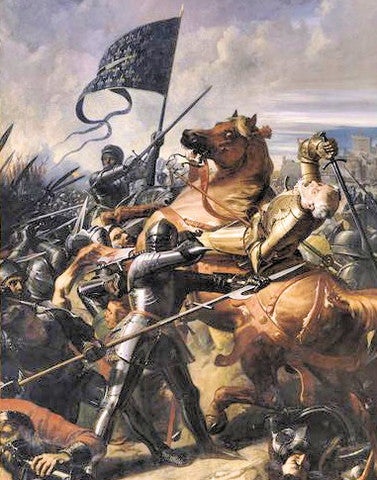
THE LOSS OF GUIENNE: The End of the Hundred Years' War
Excerpted from Oman, C. History of England from the Accession of Richard II to the Death of Richard III. London: Longmans, Green, and Co., 1906. 358-360.
"The
fate
of
Guienne
was
at
this
moment
in
the
balance.
In
1451 Charles
VII had
turned
his
victorious
arms
from
Normandy
to
the
south.
The
Bastard
of
Orleans
had
captured
one
after
another
the
outlying
bulwarks
of
Bordeaux;
Bourg
and
Blaye
had
fallen
in
May,
Fronsac
and
Libourne
early
in
June.
No
succours
arrived
from
England,
where
the
parliamentary
struggle
of
1451
was
then
at
its
height,
and
on
June
30
the
inhabitants
of
Bordeaux,
with
manifest
reluctance,
surrendered
their
city.
On
August
20
Bayonne,
the
last
fortress
where
the
English
banner
flew,
had
opened
its
gates,
and
the
subjection
of
Guienne
seemed
complete.
"But
provincial
independence
was
dear
to
the
Guiennois;
they
were
loyal
in
their
hearts
to Henry
VI,
and
they
chafed
bitterly
against
the
new
taxes
and
the
abrogation
of
old
customs
which
the
French
conquest
brought
about.
Within
six
months
of
the
fall
of
Bayonne
Gascon
nobles
and
burghers
were
visiting
London
in
secret,
to
pledge
their
faith
that
the
whole
province
would
rise
in
arms
the
moment
that
an
English
army
showed
itself
on
the
Gironde.
When
the
appeal
was
made
to
him
not
to
wreck
this
fair
chance
of
resuming
the
struggle
with
France,
York
[Richard,
Duke
of
York],
as
the
advocate
of
a
vigorous
war
policy,
could
hardly
refuse
his
aid.
He
consented,
and
a
great
effort
was
made
to
raise
an
army
for
the
invasion
of
Guienne.
In
July,
1452,
the
veteran Talbot,
who
had
been
created
Earl
of
Shrewsbury
some
years
before,
was
commissioned
to
raise
3,000
men
for
that
enterprise.
"The
struggle
of York and Somerset was
suspended
for
a
year
and
more,
while
both
parties
gave
their
aid
for
this
attempt
to
rescue
the
last
remnant
of
the
English
dominion
in
France.
Talbot
landed
on
October
17
in
the
Médoc;
on
the
21st
the
Bordelais
threw
open
their
gates
to
him.
Within
a
few
weeks
most
of
the
places
around
the
great
city
were
once
more
English.
Then
came
winter,
and
nearly
six
months
of
respite
before
the
slow-moving
Charles
of
France
launched
his
armies
against
Guienne.
By
this
time
Talbot
had
received
reinforcements
from
England
under
his
son
Lord
Lisle;
with
their
aid
he
won
back
Fronsac,
which
all
through
the
reign
of
Henry
VI
had
been
the
frontier
fortress
of
the
English
territory
in
Guienne.
It
was
only
in
July,
1453,
that
the
French
appeared,
in
overwhelming
force,
and
laid
siege
to
Castillon
on
the
Dordogne.
"Talbot
marched
out
to
its
relief,
with
every
man,
Gascon
and
English,
that
he
could
collect.
On
the
17th
he
fell
furiously
upon
the
besiegers,
who
were
stockaded
in
a
great
entrenched
camp.
So
well
were
they
covered
that
the
old
earl
did
not
see
how
he
could
turn
his
archery,
the
real
strength
of
his
army,
to
any
account.
Forming
his
whole
force
into
a
dense
column,
with
the
men-at-arms
at
the
head,
he
marched
straight
at
the
trenches.
Though
torn
to
pieces
by
the
French
artillery,
the
assailants
crossed
the
ditch,
and
strove
time
after
time
to
force
their
way
into
the
lines.
They
were
repelled,
and
presently
outlying
contingents
from
other
parts
of
the
circumvallation
came
up,
and
began
to
take
the
English
in
flank
and
rear.
At
this
moment
Talbot
was
struck
down
by
a
cannon
ball,
which
broke
his
leg.
His
sons
and
his
body-squires
fought
fiercely
in
his
defence,
but
were
slain
one
after
another.
The
French
sallied
out
of
their
trenches,
the
English
column
broke
up,
and
all
was
lost.
Talbot
and
Lisle
were
found
dead
side
by
side,
and
all
the
flower
of
their
host
had
perished.
"Nothing
can
show
better
the
loyalty
of
the
Guiennois
to
the
English
cause
than
the
fact
that
many
of
the
smaller
towns
held
out
for
two
months
after
the
disaster
at
Castillon,
and
that
Bordeaux
itself,
though
hopeless
of
succour,
did
not
surrender
till
October
19,
after
it
had
stood
a
siege
of
eighty
days.
But
this
was
the
end;
the
French
king
took
good
care
that
his
new
subjects
should
not
have
another
chance
to
rebel,
and
England
for
twenty
years
was
in
no
condition
to
think
of
sending
an
army
overseas.
Yet
the
remembrance
of
their
old
connexion
with
the
island
realm
long
remained
deep
in
the
breasts
of
the
men
of
Bordeaux;
not
only
in
the
days
of Edward
IV,
but
so
late
as
those
of Henry
VIII,
secret
messages
were
sent
to
England
from
the
Gironde,
and
a
vigorous
attempt
to
recover
Guienne
might
yet
have
found
aid
from
within.
Fortunately
for
both
parties
the
attempt
was
never
made.